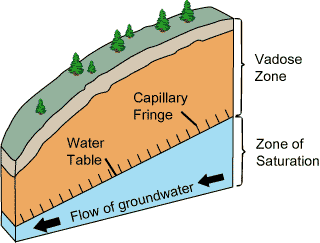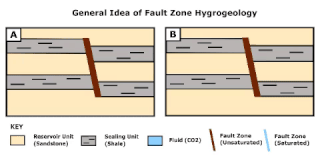
The water table is the upper surface of the zone of saturation. The zone of saturation is where the pores and fractures of the ground are saturated with groundwater, which may be fresh, saline, or brackish, depending on the locality. It can also be simply explained as the depth below which the ground is saturated.

Groundwater is the water present beneath Earth's surface in rock and soil pore spaces and in the fractures of rock formations. About 30 percent of all readily available fresh water in the world is groundwater. A unit of rock or an unconsolidated deposit is called an aquifer when it can yield a usable quantity of water. The depth at which soil pore spaces or fractures and voids in rock become completely saturated with water is called the water table. Groundwater is recharged from the surface; it may discharge from the surface naturally at springs and seeps, and can form oases or wetlands. Groundwater is also often withdrawn for agricultural, municipal, and industrial use by constructing and operating extraction wells. The study of the distribution and movement of groundwater is hydrogeology, also called groundwater hydrology.

Hydrogeology is the area of geology that deals with the distribution and movement of groundwater in the soil and rocks of the Earth's crust. The terms groundwater hydrology, geohydrology, and hydrogeology are often used interchangeably, though hydrogeology is the most commonly used.
Permeability in fluid mechanics, materials science and Earth sciences is a measure of the ability of a porous material to allow fluids to pass through it.
In hydrogeology, an aquifer test is conducted to evaluate an aquifer by "stimulating" the aquifer through constant pumping, and observing the aquifer's "response" (drawdown) in observation wells. Aquifer testing is a common tool that hydrogeologists use to characterize a system of aquifers, aquitards and flow system boundaries.
Phreatic is a term used in hydrology to refer to aquifers, in speleology to refer to cave passages, and in volcanology to refer to a type of volcanic eruption.

The vadose zone, also termed the unsaturated zone, is the part of Earth between the land surface and the top of the phreatic zone, the position at which the groundwater is at atmospheric pressure. Hence, the vadose zone extends from the top of the ground surface to the water table.
Fossil water, fossil groundwater, or paleowater is an ancient body of water that has been contained in some undisturbed space, typically groundwater in an aquifer, for millennia. Other types of fossil water can include subglacial lakes, such as Antarctica's Lake Vostok. UNESCO defines fossil groundwater as "water that infiltrated usually millennia ago and often under climatic conditions different from the present, and that has been stored underground since that time."
In science and engineering, hydraulic conductivity, is a property of porous materials, soils and rocks, that describes the ease with which a fluid can move through the pore space, or fracture network. It depends on the intrinsic permeability of the material, the degree of saturation, and on the density and viscosity of the fluid. Saturated hydraulic conductivity, Ksat, describes water movement through saturated media. By definition, hydraulic conductivity is the ratio of volume flux to hydraulic gradient yielding a quantitative measure of a saturated soil's ability to transmit water when subjected to a hydraulic gradient.
In hydrology, there are two similar but distinct definitions in use for the word drawdown:
In the field of hydrogeology, storage properties are physical properties that characterize the capacity of an aquifer to release groundwater. These properties are storativity (S), specific storage (Ss) and specific yield (Sy). According to Groundwater, by Freeze and Cherry (1979), specific storage, [m−1], of a saturated aquifer is defined as the volume of water that a unit volume of the aquifer releases from storage under a unit decline in hydraulic head.
Used in hydrogeology, the groundwater flow equation is the mathematical relationship which is used to describe the flow of groundwater through an aquifer. The transient flow of groundwater is described by a form of the diffusion equation, similar to that used in heat transfer to describe the flow of heat in a solid. The steady-state flow of groundwater is described by a form of the Laplace equation, which is a form of potential flow and has analogs in numerous fields.

Overdrafting is the process of extracting groundwater beyond the equilibrium yield of an aquifer. Groundwater is one of the largest sources of fresh water and is found underground. The primary cause of groundwater depletion is the excessive pumping of groundwater up from underground aquifers. Insufficient recharge can lead to depletion, reducing the usefulness of the aquifer for humans. Depletion can also have impacts on the environment around the aquifer, such as soil compression and land subsidence, local climatic change, soil chemistry changes, and other deterioration of the local environment.
Groundwater models are computer models of groundwater flow systems, and are used by hydrologists and hydrogeologists. Groundwater models are used to simulate and predict aquifer conditions.
The groundwater energy balance is the energy balance of a groundwater body in terms of incoming hydraulic energy associated with groundwater inflow into the body, energy associated with the outflow, energy conversion into heat due to friction of flow, and the resulting change of energy status and groundwater level.
Porosity or void fraction is a measure of the void spaces in a material, and is a fraction of the volume of voids over the total volume, between 0 and 1, or as a percentage between 0% and 100%. Strictly speaking, some tests measure the "accessible void", the total amount of void space accessible from the surface.

The Willamette Lowland basin-fill aquifer is 31,000 km2, 12,000 square mile aquifer underlying the region of Oregon and parts of Washington (state) between the Oregon Coast Range and the Cascade Range. The aquifer shares a name with the local river, the Willamette River, originating from a Clackamas Chinook word. The "mette" of Willamette was used by the Clackamas to mean water or river. The Willamette valley is home to 70% of Oregon's population, with the aquifer supplying water for agricultural, domestic, and industrial purposes. Reported in 2005, the total water use from the aquifer was 1.6 hm3 per day, with 58% going to irrigation, 24% to public supply, and 18% to industrial use. In general, the aquifer withdraw is sufficiently compensated in the long term by recharge through precipitation, however regions of the aquifer have shown long term declines, including that regions underlain by the Columbia River basalt unit. However, during the dry season from June-September, withdrawals from the aquifer result is significant seasonal variations in the ground water table height, changing by more than 60 ft. In the state of Oregon, all water is publicly owned and maintenance and protection of water is done by the Oregon Water Resources Department and the Oregon Water Resources Commission. However, local governments can provide land use permits for aquifer use, notably, use for new rural residences.
Bioclogging or biological clogging refers to the blockage of pore space in soil by microbial biomass, including active cells and their byproducts such as extracellular polymeric substance (EPS). The microbial biomass obstructs pore spaces, creating an impermeable layer in the soil and significantly reducing water infiltration rates.

Fault zone hydrogeology is the study of how brittlely deformed rocks alter fluid flows in different lithological settings, such as clastic, igneous and carbonate rocks. Fluid movements, that can be quantified as permeability, can be facilitated or impeded due to the existence of a fault zone. This is because different mechanisms that deform rocks can alter porosity and permeability within a fault zone. Fluids involved in a fault system generally are groundwater and hydrocarbons.

Coastal Hydrogeology is a branch of Hydrogeology that focuses on the movement and the chemical properties of groundwater in coastal areas. Coastal Hydrogeology studies the interaction between fresh groundwater and seawater, including seawater intrusion, sea level induced groundwater level fluctuation, submarine groundwater discharge, human activities and groundwater management in coastal areas.













